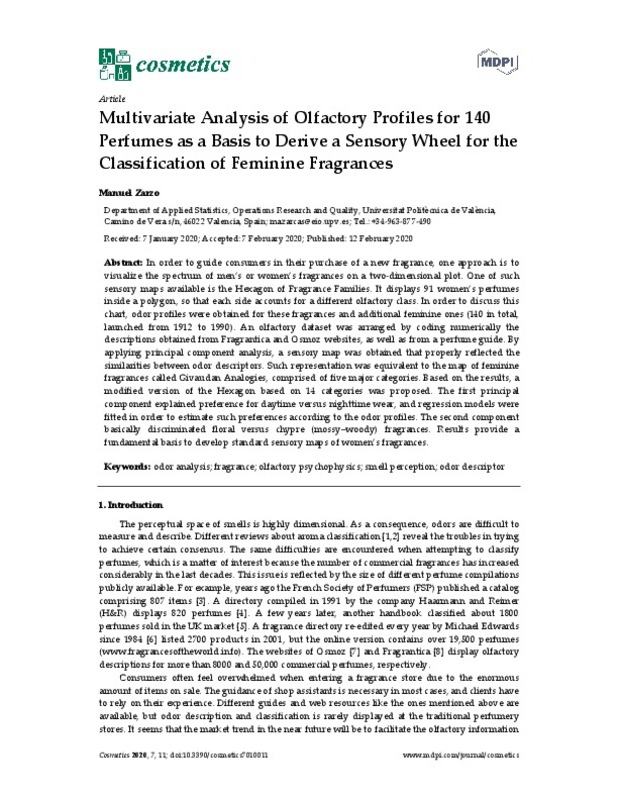Kaeppler, K., & Mueller, F. (2013). Odor Classification: A Review of Factors Influencing Perception-Based Odor Arrangements. Chemical Senses, 38(3), 189-209. doi:10.1093/chemse/bjs141
Osmoz Website for Olfactory Exploration of Men’s and Women’s Commercial Fragrances http://www.osmoz.com/perfumes/search
Fragrantica Online Encyclopedia of Perfume https://www.fragrantica.com/search/
[+]
Kaeppler, K., & Mueller, F. (2013). Odor Classification: A Review of Factors Influencing Perception-Based Odor Arrangements. Chemical Senses, 38(3), 189-209. doi:10.1093/chemse/bjs141
Osmoz Website for Olfactory Exploration of Men’s and Women’s Commercial Fragrances http://www.osmoz.com/perfumes/search
Fragrantica Online Encyclopedia of Perfume https://www.fragrantica.com/search/
Eurofragrance 2011: Feminine Fragrances Genealogy. Barcelona, Spain http://www.eurofragance.com/docs/26_2011_fem_geneology_eurofragance.jpg
World of Perfumes; Caravan Fragancias SL: Zaragoza, Spain https://www.caravanfragancias.es/content/7-mundo-del-perfume
Zarzo, M., & Stanton, D. T. (2009). Understanding the underlying dimensions in perfumers’ odor perception space as a basis for developing meaningful odor maps. Attention, Perception & Psychophysics, 71(2), 225-247. doi:10.3758/app.71.2.225
Zarzo, M. (2015). Underlying dimensions in the descriptive space of perfumery odors: Part II. Food Quality and Preference, 43, 79-87. doi:10.1016/j.foodqual.2015.02.018
Teixeira, M. A., Barrault, L., Rodríguez, O., Carvalho, C. C., & Rodrigues, A. E. (2014). Perfumery Radar 2.0: A Step toward Fragrance Design and Classification. Industrial & Engineering Chemistry Research, 53(21), 8890-8912. doi:10.1021/ie403968w
Cadoret, M., Lê, S., & Pagès, J. (2009). A Factorial Approach for Sorting Task data (FAST). Food Quality and Preference, 20(6), 410-417. doi:10.1016/j.foodqual.2009.02.010
Kostov, B., Bécue-Bertaut, M., & Husson, F. (2014). An original methodology for the analysis and interpretation of word-count based methods: Multiple factor analysis for contingency tables complemented by consensual words. Food Quality and Preference, 32, 35-40. doi:10.1016/j.foodqual.2013.06.009
Veramendi, M., Herencia, P., & Ares, G. (2013). Perfume Odor Categorization: To What Extent Trained Assessors and Consumers Agree? Journal of Sensory Studies, 28(1), 76-89. doi:10.1111/joss.12025
Zarzo, M. (2019). Understanding the Perceptual Spectrum of Commercial Perfumes as a Basis for a Standard Sensory Wheel of Fragrances. Cosmetics, 7(1), 3. doi:10.3390/cosmetics7010003
Olfactive Families of Fragrances according to the French Society of Perfumers https://www.parfumeurs-createurs.org/fr/filiere-parfum/les-familles-olfactives-102
Chastrette, M., Elmouaffek, A., & Sauvegrain, P. (1988). A multidimensional statistical study of similarities between 74 notes used in perfumery. Chemical Senses, 13(2), 295-305. doi:10.1093/chemse/13.2.295
Boelens, H. (1983). Structure—activity relationships in chemoreception by human olfaction. Trends in Pharmacological Sciences, 4, 421-426. doi:10.1016/0165-6147(83)90475-3
Fenko, A., Schifferstein, H. N. J., Huang, T.-C., & Hekkert, P. (2009). What makes products fresh: The smell or the colour? Food Quality and Preference, 20(5), 372-379. doi:10.1016/j.foodqual.2009.02.007
Zarzo, M. (2012). What is a Fresh Scent in Perfumery? Perceptual Freshness is Correlated with Substantivity. Sensors, 13(1), 463-483. doi:10.3390/s130100463
HARPER, R. (1975). SOME CHEMICALS REPRESENTING PARTICULAR ODOUR QUALITIES. Chemical Senses, 1(3), 353-357. doi:10.1093/chemse/1.3.353
Fragancias del Mundo, SL. Murcia, Spain http://fragrancesoftheworld.es
Milotic, D. (2003). The impact of fragrance on consumer choice. Journal of Consumer Behaviour, 3(2), 179-191. doi:10.1002/cb.131
Lindqvist, A. (2012). Perfume Preferences and How They Are Related to Commercial Gender Classifications of Fragrances. Chemosensory Perception, 5(2), 197-204. doi:10.1007/s12078-012-9119-7
Yokoyama, K., & Ebisawa, F. (1993). Detection and evaluation of fragrances by human reactions using a chemical sensor based on adsorbate detection. Analytical Chemistry, 65(6), 673-677. doi:10.1021/ac00054a004
[-]









